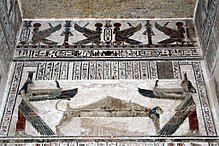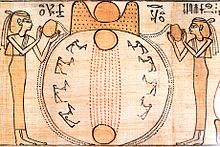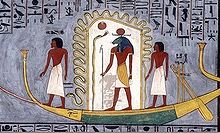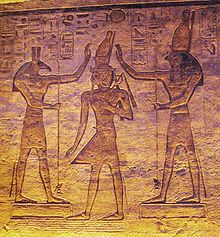Mythologia Aegyptia
Mythologia Aegyptia est corpus mythorum ex Aegypto antiqua, qui gesta deorum Aegyptiorum ad mundum intellegendum describunt. Fides? quas hi mythi exprimunt sunt partes religionis et culturae Aegypti antiquae magni momenti. Fabulae saepe in scriptis et arte Aegyptia videntur, praecipue in fabulis brevibus et materiis religiosis, inter quas sunt hymni, textus rituales, textus funerei, et ornamenta templorum. Hi fontes plenas mythorum narrationes raro continent, sed saepe solum fragmenta brevia describunt.







Aegypti antiqui, a circulis naturae inspirati, tempus praesens habebant copiam exemplarium redeuntium, contra prima temporis spatia, quae linearia fuerant. mythi, in illis temporibus primordialibus constituti, exemplar circulorum praesentium praebent. Eventus praesentes proinde eventus mythorum iterant, ergo Maat, fundamentalem universi ordinem, renovantes. In eventibus maximi momenti ex praeterito mythico sunt mythi creationis, in quibus dei universum ex chao primordiali formant; fabulae de regno Ra, dei solis, supra terram; et mythus Osiridis, de certaminibus deorum Osiridis, Isidis, et Hori contra Seth, deum disturbantem. Inter eventus ex praesente qui mythi habeantur sunt quotidianum dei Ra iter per mundum et Duat, itineris res gemella aetherea. Argumenta quae in his narrationibus redeunt sunt certamen fautorum maat et virium confusionis, momentum pharaonis in Maat conservando, et continua deorum mors et regeneratio.
Nexus interni
Notae recensere
Bibliographia recensere
- Baines, John. 1996. Myth and Literature. In Ancient Egyptian Literature: History and Forms, ed. Antonio Loprieno. Cornell University Press. ISBN 9004099255.
- Bickel, Susanne. 2004. Myth and Sacred Narratives: Egypt. In Religions of the Ancient World: A Guide, ed. Sarah Iles Johnston. Cantabrigiae Massachusettae: Harvard University Press. ISBN 0674015177.
- Conmanm, Joanne. 2003. It's About Time: Ancient Egyptian Cosmology. Studien zur Altagyptischen Kultur 31.
- David, Rosalie. 2002. Religion and Magic in Ancient Egypt. Penguin. ISBN 0140262520.
- Dunand, Françoise, et Christiane Zivie-Coche. (2002), 2005. Gods and Men in Egypt: 3000 BCE to 395 CE. Conv. David Lorton. Cornell University Press. ISBN 0801488532.
- Frankfurter, David. 1995. Narrating Power: The Theory and Practice of the Magical Historiola in Ritual Spells. In Ancient Magic and Ritual Power, ed. Marvin Meyer et Paul Mirecki. E. J. Brill. ISBN 801425506.
- Hart, George. 1990. Egyptian Myths. University of Texas Press. ISBN 0292720769.
- Hornung, Erik. (1971), 1982. Conceptions of God in Egypt: The One and the Many. Conv. John Baines. Cornell University Press. ISBN 0801412234.
- Hornung, Erik. 1992. Idea into Image: Essays on Ancient Egyptian Thought. Conv. Elizabeth Bredeck. Timken. ISBN 0943221110.
- Lesko, Leonard H. 1991. Ancient Egyptian Cosmogonies and Cosmology. In Religion in Ancient Egypt: Gods, Myths, and Personal Practice, ed. Byron E. Shafer. Cornell University Press. ISN 0801425506.
- Lurker, Manfred. (1972), 1980. An Illustrated Dictionary of the Gods and Symbols of Ancient Egypt. Conv. Barbara Cummings. Londinii: Thames & Hudson. ISBN 0500272530.
- Meeks, Dimitri. et Christine Favard-Meeks. (1993), 1996. Daily Life of the Egyptian Gods. Conv. G. M. Goshgarian. Cornell University Press. ISBN 0801482488.
- Morenz, Siegfried, et al. (1960), 1973. Egyptian Religion. Conv. Ann E. Keep. Methuen. ISBN 0801480299.
- O'Connor, David, et Stephen Quirke, eds. 2003. Mysterious Lands. UCL Press. ISBN 1844720047.
- Pinch, Geraldine. 2004. Egyptian Mythology: A Guide to the Gods, Goddesses, and Traditions of Ancient Egypt. Oxford University Press. ISBN 0195170245.
- Quirke, Stephen. 2001. The Cult of Ra: Sun Worship in Ancient Egypt. Londinii: Thames and Hudson. ISBN 0500051070. *Ritner, Robert Kriech. 1993. The Mechanics of Ancient Egyptian Magical Practice. Sicagi: The Oriental Institute of the University of Chicago. ISBN 0918986753.
- Tait, John, ed. 2003. "Never Had the Like Occurred": Egypt's View of Its Past. UCL Press. ISBN 1844720071.
- Tobin, Vincent Arieh. 1989. Theological Principles of Egyptian Religion. P. Lang. ISBN 0820410829.
Bibliographia addita recensere
- Allen, James P. 1988. Genesis in Egypt: The Philosophy of Ancient Egyptian Creation Accounts. Yale Egyptological Seminar. ISBN 0912532149.
- Anthes, Rudolf. 1961. Mythology in Ancient Egypt. Mythologies of the Ancient World, ed. Samuel Noah Kramer, ed. Anchor Books.
- Armour, Robert A. (1986), 2001. Gods and Myths of Ancient Egypt. The American University in Cairo Press. ISBN 9774246691.
- Assmann, Jan. (1984), 2001. The Search for God in Ancient Egypt. Conv. David Lorton. Ithacae Novi Eboraci: Cornell University Press. ISBN 0801437865.
- Baines, John. 1991. Egyptian Myth and Discourse: Myth, Gods, and the Early Written and Iconographic Record. Journal Near Eastern Studies 50(2). JSTOR 545669.
- Ions, Veronica. (1968), 1982. Egyptian Mythology. Peter Bedrick Books. ISBN 0911745076.
- James, T. G. H. 1971. Myths and Legends of Ancient Egypt. Grosset & Dunlap. ISBN 0448008661.
- Redford, Donald B., ed. 2001. The Oxford Encyclopedia of Ancient Egypt. Oxoniae: Oxford University Press. ISBN 0195102347.
- Sternberg, Heike. 1985. Mythische Motive and Mythenbildung in den agyptischen Tempein und Papyri der Griechisch-Romischen Zeit. Harrassowitz. ISBN 3447024976.
- Traunecker, Claude. (1992), 2001. The Gods of Egypt. Conv. David Lorton. Ithacae Novi Eboraci: Cornell University Press. ISBN 0801438349.
- Tyldesley, Joyce. 2010. Myths and Legends of Ancient Egypt. Allen Lanes. ISBN 1846143691.
- Wilkinson, Richard H. 1993. Symbol and Magic in Egyptian Art. Londinii: Thames & Hudson. ISBN 0500236631.
| ||||